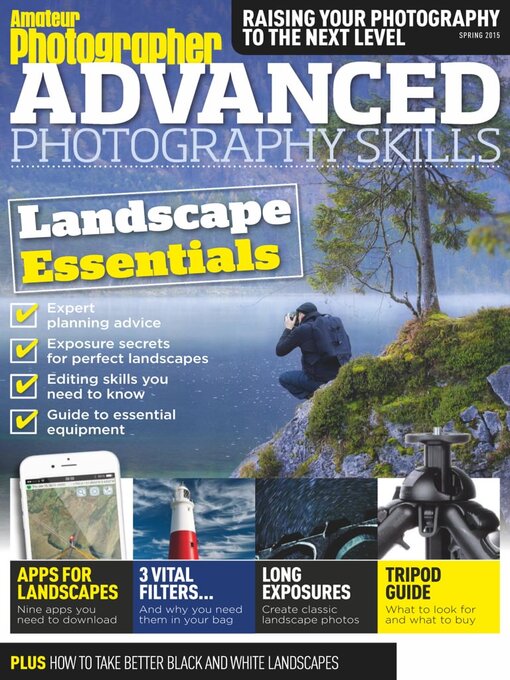Please type the description of the issue
Welcome
Planning and preparation • The key to landscape photography is proper planning and preparation. Knowing exactly when and where to shoot dramatically increases your chances of success and saves a lot of time in the process
ESSENTIAL KIT
THE WEATHER
Apps for Landscape Photographers • If you think smartphones are just for games then think again. There are many great apps that can be of real benefit to landscape photographers. We round up the apps you should have on your phone
Third party landscape lenses
Photographing Landscapes with A Telephoto lens • Landscapes don’t have to be taken with a wideangle lens. Try a telephoto optic instead
UV FILTERS
PERSPECTIVE
SUPPORTING YOUR CAMERA AND LENS
Composition • Once you have reached your chosen location, there is still work to be done before you click the shutter button and capture the scene
Composition tips from the pros • Practical tips from award-winning landscape photographers
ADAPT TO THE CONDITIONS
Sharper Landscapes • Once you have composed your shot, how do you make sure you get the sharpest image possible? Just follow our guide to get pin-sharp landscape photos
CHOOSE YOUR FOCAL LENGTH WISELY
ISO
CUSTOM WHITE BALANCE • The way that colour is rendered is an important factor in creating an image, and the best way to achieve an accurate rendition of hues and tones is to set a custom white balance. We explain how
CUSTOM WHITE BALANCE ON LOCATION
CUSTOM WHITE BALANCE POST-CAPTURE
RESCUING JPEGS • Like raw files, JPEGs can be opened in Adobe Camera Raw and adjusted using the White Balance picker tool. However, Photoshop and Photoshop Elements have tools to bring back the colour in a JPEG file, too
Dynamic Range and Metering • We explain the concept of dynamic range: what it is, how it works and what effect it has on the images you take
WHAT THE CAMERA SEES • How light is captured by a camera’s sensor, and what effect dynamic range has on the tones displayed
METERING HIGHLIGHT AND SHADOWS
DYNAMIC RANGE: RAW AND JPEG
BIT DEPTH EXPLAINED
Shooting to the right • There is an easy technique that will help you to greatly reduce image noise, or even eliminate it – let more light into your images
Three filters you can’t live without • Despite the powers of Photoshop, there’s still an essential place for filters in your kit bag, as Jeremy Walker reveals
KIT LIST
Polarisers • Remove reflections and boost colour saturation
Graduated neutral density filters • Balance the foreground and sky for perfect landscapes taken in-camera
USING AN ND GRAD
KIT LIST
Neutral density filters • For extended exposures and creative effects, the ND filter offers all you need
KIT LIST
B&W Landscapes • Ian Bramham explores the way that shooting in mono can evoke feelings and emotions that are infinitely harder to capture in colour
TOP TIPS
SIMPLICITY: WHY IT WORKS
B&W Colour Filters • Colour filters are used with B&W film to control the brightness of different colours, but the same effect can be achieved digitally
Complete guide to shooting infrared images • You may not be able to see infrared light, but a camera can. We explain everything you need to know about infrared photography
WHITE BALANCE
USING FILTERS
LENSES AND FILTERS
SWAPPING CHANNELS • One popular technique when shooting digital infrared images is to swap the red and blue channels around. Having taken a custom white balance reading, the resulting image should have a red/amber sky. To turn this into a bright blue...

